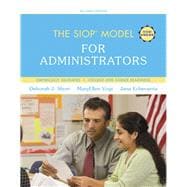Note: This is the bound book only and does not include access to the Enhanced Pearson eText. To order the Enhanced Pearson eText packaged with a bound book, use ISBN 0134403274.
A user-friendly guide for administrators that provides the knowledge, tools, and resources necessary to understand and oversee the implementation of the SIOP® Model for teaching English learners.
A must-read for all administrators who work with English learners, The SIOP® Model for Administrators, 2/e provides the tools needed for supervising the education of this growing population of learners. It introduces a comprehensive, coherent, research-validated model–the SIOP Model–for teaching English learners and helping them meet rigorous academic standards, and includes concrete strategies and advice from other administrators to help principals, coordinators, and others implement the model, including guidance for getting started and sustaining the intervention. While summarizing 20 years of research that has proven the SIOP® Model’s effectiveness for all grades and subject areas, the book explains the second language acquisition process so administrators can understand how students best learn new languages. The Enhanced Pearson eText features embedded videos.
Improve mastery and retention with the Enhanced Pearson eText*
The Enhanced Pearson eText provides a rich, interactive learning environment designed to improve student mastery of content. The Enhanced Pearson eText is:
- Engaging. The new interactive, multimedia learning features were developed by the authors and other subject-matter experts to deepen and enrich the learning experience.
- Convenient. Enjoy instant online access from your computer or download the Pearson eText App to read on or offline on your iPad® and Android® tablet.*
-
Affordable. The Enhanced Pearson eText may be purchased stand-alone for 50-60% less than a print bound book.
*The Enhanced eText features are only available in the Pearson eText format. They are not available in third-party eTexts or downloads.
*The Pearson eText App is available on Google Play and in the App Store. It requires Android OS 3.1-4, a 7” or 10” tablet, or iPad iOS 5.0 or later.










